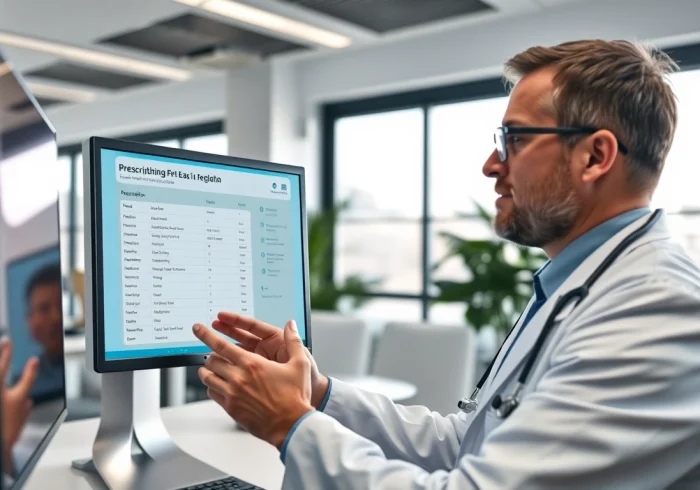Understanding the Landscape of Top Rated Prescription Applications
Defining Prescription Applications
Prescription applications have revolutionized the way patients manage their medications and interact with healthcare services. They are software programs designed to enable users, whether patients or healthcare providers, to handle prescriptions efficiently and securely. These applications range from mobile apps to web-based platforms, offering functionalities like prescription refills, reminders, and drug information. As healthcare shifts towards digital solutions, top rated prescription applications emerge as vital tools for enhancing patient compliance and medication management.
Importance of User-Friendly Design
User-friendly design is essential in the development of prescription applications. An intuitive interface ensures that users of all ages and tech-savviness can navigate the app without frustration. Elements such as clear navigation paths, easy-to-read fonts, and logical information architecture all contribute to a positive user experience. An effective application allows users to quickly understand how to manage prescriptions, access health information, and communicate with healthcare providers, thus improving overall effectiveness and user satisfaction.
Market Trends and Growth Predictions
The prescription application market is expected to witness exponential growth in the coming years. Factors fueling this growth include the increasing prevalence of chronic diseases that require continuous medication, rising adoption of smartphones, and demand for efficient healthcare solutions. Additionally, the integration of telehealth services within these applications provides a seamless experience for users. As technology advances, applications are evolving with features like AI-driven medication reminders and personalized healthcare advice. Regulatory support, especially post-pandemic, also bodes well for the industry’s expansion.
Key Features of Top Rated Prescription Applications
Ease of Prescription Management
One of the primary features of top rated prescription applications is ease of prescription management. Users can easily view their medication lists, track refills, and manage multiple prescriptions through a single interface. These applications often provide personalized dashboards that display important medication-related information, such as refill dates and dosage reminders. Moreover, many applications allow users to upload their prescriptions digitally, ensuring that they have quick access to necessary medications without visiting a pharmacy.
Real-Time Communication with Pharmacists
Real-time communication with pharmacists is another crucial feature supported by the best prescription applications. Enabling direct messaging or chat functionality within the app allows users to consult pharmacists for clarifications on medications, inquire about potential drug interactions, or discuss side effects. This immediate access to professional guidance enhances patient safety and fosters better medication adherence by empowering users to manage their health confidently.
User Experience Enhancements
User experience enhancements are vital in improving user retention and satisfaction. Features such as personalized notifications, streamlined onboarding processes, and educational resources about medications can make a significant difference. Top rated prescription applications often include gamification elements, such as rewards for consistent medication adherence, which can further motivate users to engage with the app. Enhancing the overall user experience creates a more enjoyable and effective platform for managing health.
Comparing Popular Features in Top Rated Prescription Applications
Medication Reminders and Alerts
Medication reminders and alerts are indispensable features for any prescription application. These can include push notifications that remind users when it’s time to take their medication or refill a prescription. Customizable reminder settings allow users to choose how frequently they wish to be notified, thereby catering to individual preferences. Such reminders significantly improve adherence rates, especially in populations with complex medication regimens.
Pricing Transparency Features
Pricing transparency features provide users with valuable insights into the cost of their medications. Many top rated prescription applications offer tools that allow users to compare prices across different pharmacies, ensuring they can find the best deals for their medications. This transparency is crucial, particularly in the current healthcare climate, where users seek to maximize their healthcare investments. Some applications also provide discount programs and coupons that can further alleviate the financial burden associated with prescriptions.
Integration with Healthcare Providers
Integration with healthcare providers streamlines the prescription process. Top rated applications often enable users to share their medication history with healthcare providers easily, facilitating informed discussions during appointments. This integration minimizes unnecessary prescriptions, helps manage existing conditions more effectively, and fosters overall coordination of care. Some applications also have options for telehealth consultations, bridging the gap between patients and practitioners clearly and efficiently.
Challenges Users Face with Prescription Applications
Data Privacy Concerns
Despite the numerous benefits that prescription applications offer, users face significant challenges such as data privacy concerns. With the sensitive nature of health information, users often worry about how their data is handled. To combat these challenges, application developers must prioritize security measures, such as encrypting data transmissions and ensuring compliance with regulations like HIPAA. Transparency about data usage policies is key to building trust with users.
Adapting to Technological Changes
As technology evolves rapidly, users must adapt to new updates and features within applications. This can be particularly challenging for older adults or those with limited technological proficiency. Developers should consider inclusive design principles when creating applications, ensuring that even those who may be less tech-savvy can benefit. Offering tutorial resources, customer support, and intuitive interfaces can help mitigate the learning curve associated with new technology.
Navigating Complex Healthcare Systems
Navigating the complexities of healthcare systems can also present challenges for users of prescription applications. Many users may struggle to understand their insurance policies, including which medications are covered and at what cost. Integration with health insurance providers, coupled with clear guidance within the application, can enhance users’ experiences by demystifying these complexities and enabling more informed healthcare choices.
Future Directions for Top Rated Prescription Applications
Adopting Artificial Intelligence for Personalized Care
The future of top rated prescription applications looks promising with the adoption of artificial intelligence (AI). AI technology can analyze user data, providing personalized insights and recommendations based on individual health needs. For instance, AI can suggest medication adjustments based on user adherence patterns or predict potential health issues before they arise. This level of personalization can transform the way users engage with their healthcare, making it more proactive and tailored.
Expanding Accessibility for Diverse User Groups
Expanding accessibility is a critical consideration as prescription applications develop further. Many applications currently cater to a tech-savvy demographic, but future iterations must consider diverse user groups, including older adults, individuals with disabilities, and those from various cultural backgrounds. Enhancements such as language options, voice-activated commands, and simplified navigation will broaden the accessibility of prescription applications, fostering inclusivity in healthcare technology.
Enhancing Interoperability Across Platforms
Enhancing interoperability across platforms will be crucial for the future success of prescription applications. As users often engage with multiple health-related applications, ensuring seamless communication and data sharing between these systems will enhance user experience. Interoperability can improve coordination between various healthcare providers, allowing for better-informed decisions regarding prescriptions and patient care.



